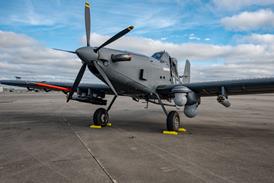Guy Norris/LOS ANGELES
BOEING IS FLIGHT-testing a strengthened aerodynamic fairing on the Rolls-Royce Trent 800-powered 777 after the discovery of fatigue cracks following its first flight on 26 May. It is also determining whether the problem could affect General Electric and Pratt & Whitney-powered versions.
Flight-testing was held up for more than a month while a strengthened fairing for the strut was made and installed. Testing resumed with a second flight on 1 July, and a total of more than 25h has been accumulated since then.
"We are doing some testing to do with an aerodynamic fairing and its ability to withstand fatigue," says Boeing, which is responsible for the entire structure surrounding and supporting each engine offered on the 777. "We are collecting and analysing data to see if this is peculiar to the Rolls-Royce combination or not," the company adds.
Boeing says that the affected area "...is not structural, and does not involve the connection of the engine to the wing". The strut fairings and structure are made of composite materials and aluminium, and inconel or titanium for the hot-section parts. The tests are important, because the upper aft fairing, where the problems are thought to be centred is common to all engine installations and covers hydraulic system lines and the drag brace.
Boeing says that the engine itself is "performing well" during the renewed flight tests, which have included flutter tests and basic engine/airframe performance evaluation. The company says that scheduled delivery of the first Trent-powered 777 to Thai Airways International is still on target for January 1996.
Meanwhile, resumption of testing of the GE90-powered 777 is expected following a successful a birdstrike test on 7 July at Villaroche, France, scheduled to take place as Flight International went to press. The company rushed the redesigned spacer platform to France on 5 July, and began immediate preparations for the test. Certification of the GE90-powered 777 is now well behind schedule following the grounding of the two test aircraft in late May.
GE originally planned to recommend restarting of flight testing to Boeing after successfully completing dynamic tests at Wright Patterson AFB, Ohio, at the start of July. It then decided to wait for the outcome of the fan test in France as a fuller vindication of the redesign.
The company says that the US Federal Aviation Administration has accepted the new production software for the GE90 digital engine control, which will prevent a recurrence of the 4 May surge event. The new software, which reschedules the operation of the variable guide vanes, was tested successfully on a ground engine at Peebles, Ohio, at the end of June.
Source: Flight International























